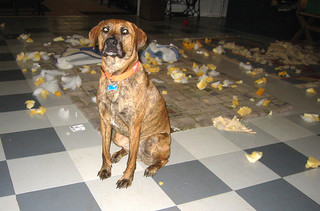 I recently worked with a client whose yard was a war zone. Torn up sprinkler lines, chewed landscaping, busted and bruised children’s toys littering the battlefield of their yard. You guessed it, there dog was a destruction monster. In doing simple calculations the owner confided that the dog had done over $10,000 in damage to their property.
I recently worked with a client whose yard was a war zone. Torn up sprinkler lines, chewed landscaping, busted and bruised children’s toys littering the battlefield of their yard. You guessed it, there dog was a destruction monster. In doing simple calculations the owner confided that the dog had done over $10,000 in damage to their property.
Thankfully there are ways to fix dog chewing. Unfortunately, most people are too lazy or ineffective with their training methods to get it fixed. Don’t be that person. Follow these steps for success:
- Supervision.
One of the biggest problems people have with dog chewing is they give their dogs too much freedom before they’ve earned it. Note, dogs need to EARN freedom. If freedom is given without training you are in a great position for a $10,000 chewing bill.This rule applies to both puppies and adults. If your dog, whatever the age, is prone to chewing then that dog shouldn’t have the freedom to chew. Simple as that. If you can’t be home during the day then you need to find a place where the dog can be safe and not chew. Perhaps that is a crate, a bathroom, a garage, a kennel run, or whatever.Dog training is all about communication. When you are gone at work for 8 hours you can’t communicate a darn thing. You need to set your dog up so that chewing isn’t an option.Don’t worry, this isn’t a forever thing. As you address the chewing issue you can gradually give your dog more and more freedom and end up with a dog that is able to be left out during the day. Rome wasn’t built in a day, though, and you aren’t going to be leaving your dog loose in the house or yard all day by tomorrow.The same is true for when you are home, though. If your dog is chewing then what the heck is he doing alone in the family room for the last hour? Why is he allowed to sneak off into your kids room and grab toys?A common complaint I’ve heard from dog owners is, ‘well, I can’t watch him 24 hours a day!’My response is that you may have wanted to get a stuffed animal, then. Many dogs need 100%, not 80, 85, or 96%, supervision during their training period. Every puppy I’ve ever raised has either had a set of eyes on him or been in a crate until about 8-12 months of age. Period. As a result, I’ve never had anything destroyed in my home. That includes dogs that I’ve raised and the hundreds of dogs who have passed through my home for training over the last decade.
Now, because I’m so over the top with my supervision I typically get to a point by about 8-18 months where the dog doesn’t need any supervision. I didn’t start there, though, and neither can you. Your dog needs supervision until he’s proven that he doesn’t need it.
- Outlets for energy and intelligence.
Many dogs I meet are chewers because they have no outlets. They don’t get walked, they don’t get trained, they don’t get much attention.What outlets do you provide your chewing dog? Do you get her out on a long enough walk? Have you done some training today? Have you played with her?What about chew toys? Have you provided enough? And toys that are interesting enough?Outlets need to provide for the physical exhaustion and the mental workout. - Correct chewing.
I’ve got to tell you, the next time I hear a so-called professional dog trainer say that when a dog is chewing something bad you should simply replace it I think I might scream.This new school style of training where you don’t correct the dog and simply redirect the dog is ludicrous.You NEED to train your dog that it is 100% WRONG to chew your shoes, furniture, iPods, computer cords, etc. That may be a leash correction, spray bottle, or other. But if you hear a trainer tell you, ‘no, no, no. Don’t correct him! Just redirect him to something else,’ then you need to be running for the hills. That method doesn’t even work in theory let alone application.
In my training DVDs we talk about another form of correcting called chewing called K9 entrapment. It sounds devious….but it works. I’ll save that for the DVDs, though.
Apply this for dog chewing and you’ll be in great shape.
Image credit: an iconoclast







